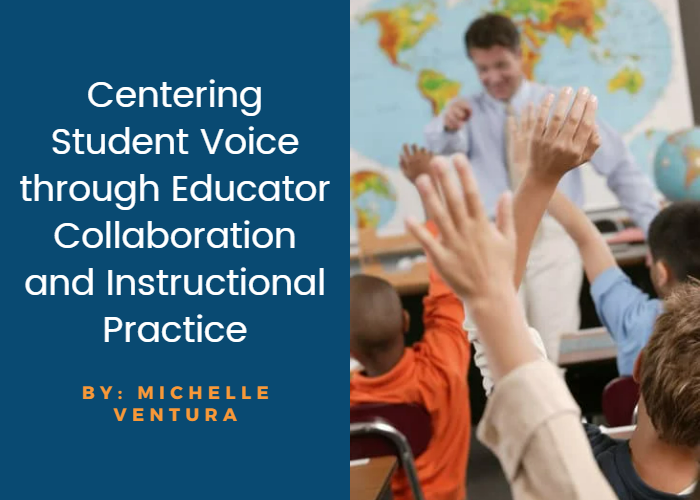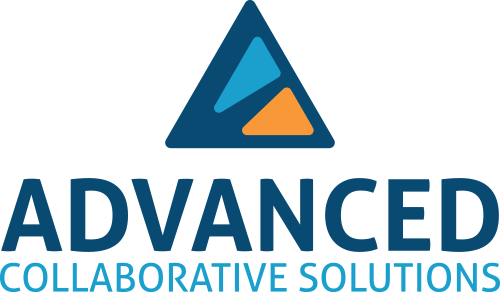Centering Student Voice through Educator Collaboration and Instructional Practice

By: Michelle Ventura
What image comes to mind when you picture a typical K-12 classroom? Do you see a teacher lecturing at the board with rows of silent students in front of him or her? Are students completing a worksheet independently at their desks? Or do you envision a lively student-led discussion with the teacher in the background prompting and questioning? While the former may be what we experienced as children in our own schooling, the latter is certainly an ideal learning environment if we want students to develop problem-solving and critical thinking skills.
However, that ideal state can be a difficult one to attain, especially on your own. If you are an educator looking to shift from being a “sage on the stage” to a “guide on the side,” start by establishing a collaborative culture in your PLC or teaching team. In fact, according to Professor John Hattie, “Collective teacher efficacy is ranked as the number one factor influencing student achievement” (Hattie, 2016), meaning that teams of educators with a shared belief in effective collaboration statistically have a greater influence on a child’s performance than their socioeconomic status, parental involvement, or home environment. What do you do once you have your collaborative team? Try a framework like Achievement Teams, where educators follow four simple steps to make data-driven decisions about their instructional practices. In this framework, people (more specifically, educators) drive the solutions rather than curriculum.
Once you have your team, a shared belief in your collective efficacy, and a solid framework to follow, try the following strategies to amplify student voices and increase student ownership in your classroom across all three levels of learning (surface, deep and transfer). This free resource from Advanced Collaborative Solutions gives additional ideas!
Strategies for Enhancing Student Voice and Ownership in the Classroom
1. Card Sorts (Surface Level Learning)
Looking for a way to introduce a new concept, tap into background knowledge, or practice vocabulary? Look no further than the card sort! After having students create one card per concept or vocabulary term, task student groups with sorting cards into either specific categories or into categories they choose. Then, ask students to explain their thinking and discuss connections with other groups’ sorting results.
2. Class Discussion (Deep Level Learning)
Advance preparation is key in facilitating an effective class discussion. First identify major themes or key understandings you want students to walk away with, then craft purposeful questions that invite students to speak, wonder, and explain their thinking surrounding those topics or themes. During quality formal class discussions, the teacher designs a scenario for students to discuss a specific topic. The teacher becomes the facilitator with prepared, purposeful questions and invites students to speak, ask questions, and justify their thinking. Class discussion can occur in a variety of formats (partners, small groups, fishbowl, Socratic seminar) so choose the approach that best suits you and your students. When getting started, be sure to provide students with sentence frames that encourage open dialogue – an anchor chart with questions or stems (like “What makes you think that?” or “I’d like to add on to you…” or “I respectfully disagree…”) can work wonders in enhancing student discussion.
3. Reciprocal Teaching (Deep Level Learning)
Consider this strategy as the ultimate check for understanding of reading comprehension. In reciprocal teaching, teachers and students share in the teaching and discussion through a structured dialogue. The teacher begins by modeling four steps: summarizing, questioning, clarifying, and predicting. Then students work in small groups, rotating the “teacher” or “leader” role to walk their group through the same four-step process about their reading assignment. Reciprocal teaching positions students as facilitators, teaches them to ask meaningful questions, and makes texts more comprehensible.
4. Peer Tutoring (Transfer Level Learning)
Peer tutoring is a teaching strategy that pairs students together to work on various skills, such as academic content, critical thinking, problem-solving, or even social and emotional skill development. This strategy has been shown to improve student relationships and academic achievement. Peer tutoring benefits the tutor because they learn to become leaders, improve communication skills, and gain a deeper understanding of content as they teach their peers. The tutee benefits from the relationship because they gain confidence, form peer relationships, and improve communication.
Not much can stop an educator armed with both effective instructional practices and a collaborative team, but sometimes these things are hard to come by. If you’re looking to expand your instructional toolkit, check out this Instructional Strategy Flip Book. If you and your team want to better harness your impact, assess your team’s current collaboration and work together to improve. After all, educator collective efficacy has the power to change student lives.

